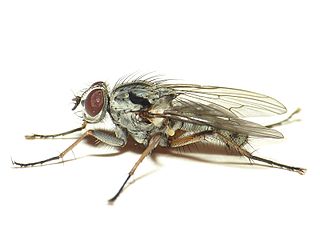
Calyptratae is a subsection of Schizophora in the insect order Diptera, commonly referred to as the calyptrate muscoids. It consists of those flies which possess a calypter that covers the halteres, among which are some of the most familiar of all flies, such as the house fly.

The Anthomyiidae are a large and diverse family of Muscoidea flies. Most look rather like small houseflies. Most species are drab grey to black. Many Pegomya are yellow, and some members of the genera Anthomyia and Eutrichota are patterned in black-and-white or black-and-silvery-grey. Most are difficult to identify, apart from a few groups such as the kelp flies that are conspicuous on beaches.

Pegomya bicolor is a species of fly in the family Anthomyiidae. It is found in the Palearctic. For identification see Host plants include Persicaria virginiana, Rumex acetosa, Rumex acetosella, Rumex conglomeratus, Rumex crispus, and Rumex obtusifolius.
Chirosia inspinata is a species of fly from the Chirosia genus, Anthomyiidae family, described by Masayoshi Suwa in 1983. According to Catalogue of Life The species of Chirosia inspinata does not have known subspecies.
Neochirosia nuda is a species of dung fly in the family Scathophagidae. It is a univoltine leaf miner of Maianthemum canadense and Polygonatum pubescens.
Pegomya carduorum is a species of root-maggot flies.
Eutrichota geomyis is a species of root-maggot flies in the family Anthomyiidae.
Eutrichota gopheri, the gopher tortoise burrow fly, is a species of root-maggot flies in the family Anthomyiidae.
Eutrichota spinosissima is a species of root-maggot flies in the family Anthomyiidae.
Pegomya atlanis is a species of root-maggot fly. It feeds on Chenopodium album as a leaf miner.

Eustalomyia is a genus of root-maggot flies in the family Anthomyiidae. There are about five described species in Eustalomyia. They are kleptoparasites that consume paralyzed prey meant for Crabronidae larvae.
Chirosia filicis is a species of root-maggot flies in the family Anthomyiidae.

Chirosia is a genus of root-maggot flies in the family Anthomyiidae. There are over fifty described species in Chirosia.
Delia pluvialis is a species of root-maggot flies in the family Anthomyiidae.
Leucophora unilineata is a species of root-maggot flies in the family Anthomyiidae.
Leucophora marylandica is a species of root-maggot flies in the family Anthomyiidae.
Parallelomma vittatum is a species of dung fly. Larvae are leaf miners of numerous plants, including Maianthemum dilatatum, Polygonatum pubescens, Trillium undulatum, Cypripedium acaule, Cypripedium reginae, and others. They are active from May through October, and can have two generations in a single year.
Eutrichota cylindrica is a species of root-maggot flies in the family Anthomyiidae.
Chirosia gleniensis is a species of root-maggot flies in the family Anthomyiidae. It is a leaf miner of Onoclea sensibilis.
Chirosia flavipennis is a species of root-maggot flies in the family Anthomyiidae. It is a leaf miner of the host species Pteridium aquilinum.




